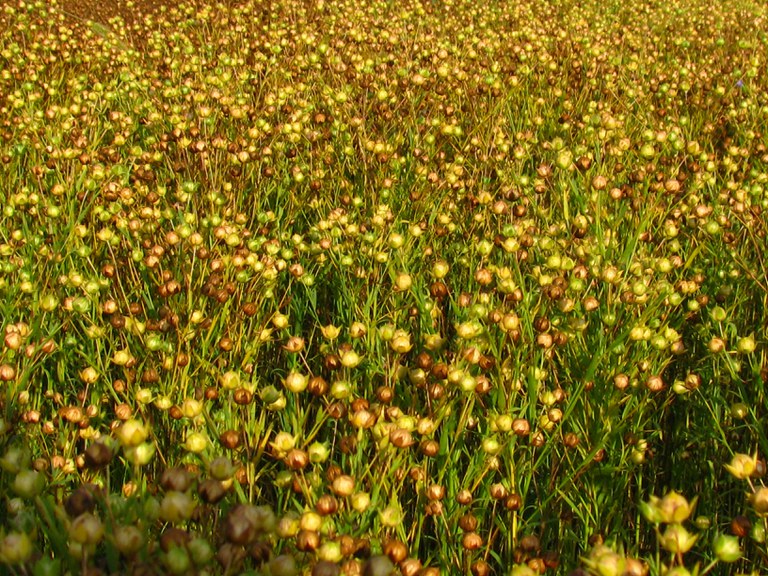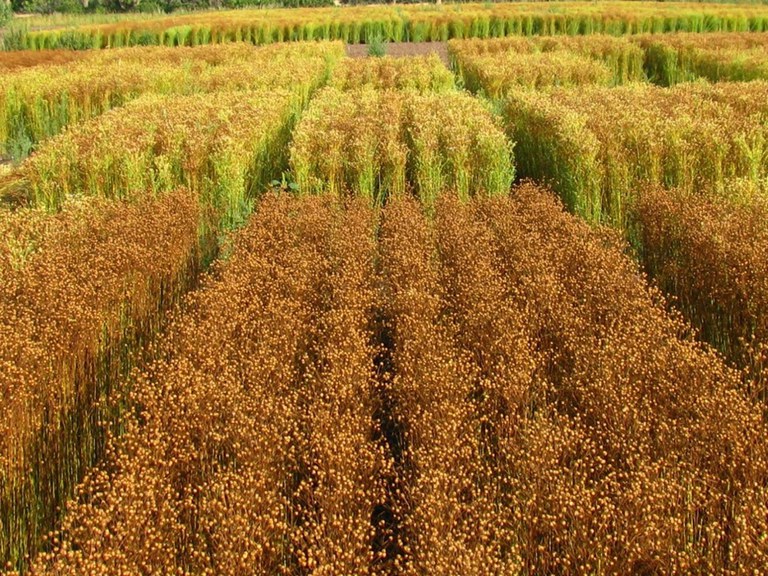Influence of Harvest Management Strategies on Flax Yield and Quality
The practice of harvesting a crop of flax has evolved over the years as both equipment and technologies change. Traditionally, flax would be swathed into a windrow to promote plant dry down with threshing by the combine to follow. Now, most flax acres are direct-harvested, often after application of a desiccant to speed up dry down of both the flax plants and any weeds present. Producers initiate a flax harvest operation once the plant has reached physiological maturity (PM). At PM, the optimum flax seed yield, oil content and oil quality should be achieved. PM in flax is defined as when 75% of the seed bolls have reached a brown color. This determination of brown is often not a clear or straightforward assessment since flax bolls will express wide variations of this color as the plant matures.
 Flax approaching maturity showing variations of boll color change.
Flax approaching maturity showing variations of boll color change.
The procedures a producer follows when harvesting flax are influenced by weed infestations, uneven stand, available labor and pending weather conditions. These factors, along with the challenges of assessing the 75% brown boll stage, may result in windrowing or applying a desiccant prior to actual physiological maturity. In theory, terminating flax before PM would cause reduced seed yield and oil content or quality would likely be impacted. This effect may be most significant when using a fast-acting desiccant versus one that results in slower rates of plant dry down. When slightly immature flax is swathed and laid in a windrow, we expect some degree of continued maturation as long as temperatures are moderate. Likewise, we would expect a slow acting desiccant to allow some degree of continued maturation for a limited time.
Flax processors and end-users have observed moderate variations in oil content and oil quality (i.e. ALA, alpha-linolenic acid) over the years. Minimal explanations exist as to why these variances occur. Our hypothesis was that harvest management might play a role in influencing flax oil content and quality.
Field trials were conducted at the NDSU Carrington Research Extension Center from 2017 to 2019 to determine how the different harvest approaches used by farmers may affect seed yield and oil content and quality. Objectives of the trial were to: 1) Compare windrowing and desiccation to natural plant dry down. 2) Determine if harvest at a stage prior to assessed PM influenced seed yield, oil content and quality. 3) Assess multiple herbicide desiccants to determine effective rate of plant dry down and influence on yield and oil.
Windrowing and desiccant application were initiated at 50% and 75% brown boll color representing two stages of maturity. Three herbicide desiccants were evaluated at each maturity stage including glyphosate and flumioxazin, which are both registered, and one product where a label is being pursued. A control treatment where flax dried down naturally to harvest moisture was established to allow comparison to harvest management strategies.

The foreground demonstrates increased rate of flax plant drydown in response to application of a desiccant.
Trial results indicate that defining when flax is mature is very important to optimize seed yield when choosing among desiccants. However, oil content and oil quality were minimally effected by harvest timing or the desiccant used. Glyphosate and flumioxazin are slower-acting desiccants that allowed for a more gradual plant dry down resulting in similar seed yield when applied at either harvest timing and when compared to the control treatment. However, the other desiccant evaluated is a fast-acting product that reduced seed yield significantly across both harvest timings suggesting that at 75% brown boll stage, complete dry matter deposition had not occurred.
Based on this study the variations in oil and alpha-linolenic acid content in flax that are observed by end-users in the marketplace are not likely due to the timing a producer initiates harvest nor the desiccant they may have used. However, the potential for producers to use a fast-acting desiccant in the future will require greater attention to the crop stage when the product is applied to prevent reductions in seed yield. Further research to define flax boll color characteristics that correlate with optimized seed yield will be needed to effectively use a fast-acting desiccant.
Blaine G. Schatz
Blaine.Schatz@ndsu.edu
Director and Agronomist


